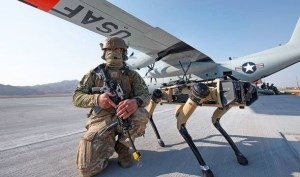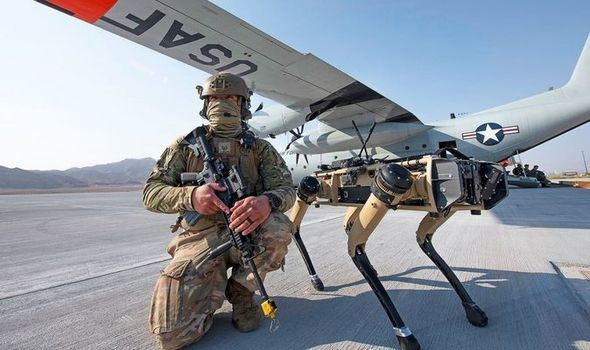A US robotics company has developed a new robotic dog which could soon become man’s best friend in war zones.
Next month, US Defense Department contractor Ghost Robotics will unleash four of its semi-autonomous robots at Tyndall Air Force Base in Florida.
These “menacing” four-legged bots could be a step toward introducing robot dogs to conflict zones, the company says.
The high-tech canines, known as Vision 60, are being touted as a security enhancement.
According to the military, they are part of a plan to replace stationary surveillance cameras at the Air Force base.
Ghost Robotics, however, believes the machines may go beyond just patrolling in the not-too-distant future.
“We can see them in war zones, working with bombs, scouting, targeting, probably in 2022,” said Jiren Parikh, chief executive of Ghost Robotics. “These can really become a warfighter’s best friend.” The military says the robots have the potential to be used in a “contingency, disaster or deployed environment.”
On the Air Force base, the robots will enable humans to focus on other tasks.
Made to move like real animals
Founded in 2015, Philadelphia-based Ghost Robotics designed the four-legged drone alternative to “feel the world” and remain balanced when prowling through water, tall grass and other terrain.
The new deal follows a recent collaboration between Ghost Robotics and the Australian Army.
Last year, Australia experimented to find out how the country could leverage the robots in the “future of land warfare.”
The computerised canines can operate in subzero temperatures and are made to move like real animals, the company says. Also referred to as “unmanned ground vehicles” or UGVs, they can climb steps, run and turn themselves upright if knocked over.
The robots are equipped with motors that control the legs and adjust based on changes in ground pressure. Relying primarily on motors for navigation is what sets Ghost Robotics' machines apart from similar devices such as Boston Dynamics' mobile robot “Spot”, which depend on a host of sensors.
“A core design principle for our legged robots is reduced mechanical complexity when compared to other legged robots, and even traditional wheeled-tracked UGVs,” the company says.
Boston Dynamics, a robotic dog pioneer, is a much larger company, employing more than 300 people across two offices. Ghost Robotics has fewer than 25 employees.
Can be assembled in 15 minutes
Ghost Robotics’ dog-sized machines have onboard cameras and sensors to monitor for intruders along the base’s perimeter. The robots can trot along for up to 7½ hours before needing a recharge. The machines, which are not meant to replace real military dogs, can be assembled in 15 minutes, while damaged limbs can be replaced even faster.
The machines are equipped with WiFi and 4G LTE to send live information to its operator.
Ghost Robotics has shipped over 100 of its robot dogs in 2020 and plans to send more than 250 in 2021.
The robots are part of the military’s ambition for an Advanced Battle Management System that uses a network of innovations such as artificial intelligence and robotics to detect and defend against threats.
Last month, the canines showcased their abilities during a test run at Tyndall, where they were operated using a remote control. Once they are programmed with a patrol path to follow, they will roam semi-autonomously with their handlers able to control them via virtual reality headsets when necessary, the Air Force says.
The military-grade canines allow defenders that would otherwise be patrolling to focus on training, security and overall situational awareness across the base.
Tyndall is the first military base in the US to integrate the robots full time.


